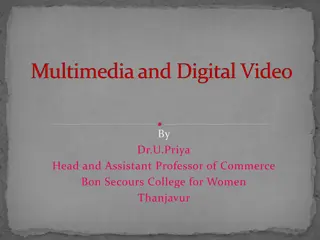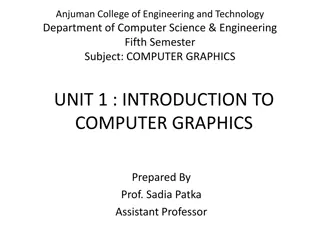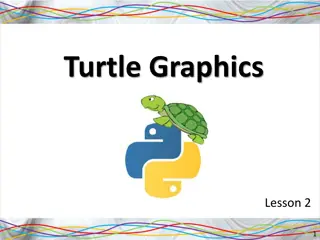Introduction to Computer Graphics and Multimedia Applications
This lecture covers the fundamentals of computer graphics and multimedia applications, focusing on quadric surfaces, polygon meshes, and different mesh representations such as explicit mesh, vertex pointer representation, and edge list representation. It explains how quadric surfaces are defined implicitly by equations and how meshes are composed of vertices, edges, and polygons. The importance of efficient space and time tradeoffs in representing meshes is highlighted.
Download Presentation

Please find below an Image/Link to download the presentation.
The content on the website is provided AS IS for your information and personal use only. It may not be sold, licensed, or shared on other websites without obtaining consent from the author.If you encounter any issues during the download, it is possible that the publisher has removed the file from their server.
You are allowed to download the files provided on this website for personal or commercial use, subject to the condition that they are used lawfully. All files are the property of their respective owners.
The content on the website is provided AS IS for your information and personal use only. It may not be sold, licensed, or shared on other websites without obtaining consent from the author.
E N D
Presentation Transcript
Subject: Computer Graphics and Multimedia Applications Code: BCA401N Lecture 22 BY Dr MAYUR RAHUL (E762) DEPARTMENT OF COMPUTER APPLICATION UIET, CSJM UNIVERSITY, KANPUR
OUTLINE Quadric surfaces Polygon meshes
Quadric Surfaces A quadric surface is implicitly defined by an equation f(x, y, z) = 0, where f is a quadric polynomial in x,y,z. Example quadrics are circles, spheres, ellipsoids, etc.
Polygon meshes Amesh is a set of vertices, edges, and polygons. Each edge in the mesh is shared by at most two polygons. An edge connects two vertices. A polygon is a closed sequence of edges. The key issue with meshes is one of representation and the ensuing space/time tradeoffs.
An explicit mesh representation An explicit mesh representation Requires that each polygon be specified by a list of vertices. Such a representation duplicates many vertices and does not identify shared vertices and edges. Rendering such a mesh would result in redrawing all shared edges. Thus, this representation is neither space nor time efficient.
A vertex pointer representation A vertex pointer representation Requires that each polygon be specified as a list of pointers (indices) into a list of vertices. Each vertex is stored exactly once. The space overhead is the list of pointers maintained for each polygon. The representation identifies shared vertices but still does not identify shared edges so redrawing occurs. This representation is space efficient/time inefficient.
An edge list representation An edge list representation Requires that each polygon be specified as a list of pointers (indices) into a list of edges. Each edge is stored exactly once. An edge is composed of its two vertices and the polygon to which it belongs. Each vertex is stored exactly once. The space overhead is the list of edges and the list of pointers for each polygon. To render an outlined mesh, it is necessary to render only the edge list. To render filled polygons is equally efficient. Shared edges are not redrawn. This representation is moderately space efficient and very time efficient.
REFERENCES https://www.tutorialspoint.com/dbms/dbms_overview.htm https://www.studytonight.com/dbms/database-model.php https://www.geeksforgeeks.org/introduction-of-process-synchronization/\ https://www.javatpoint.com/os-process-synchronization-introduction























